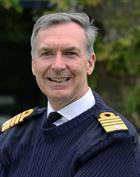Navy has made great strides but must rise to future challenges
The Royal Navy must continue its technological and structural revolution to meet the challenges it – and the nation – face over the next decade.
First Sea Lord Admiral Sir Tony Radakin says tremendous progress has been made over the past two years of the transformation programme.
But in a wide-ranging interview, he said the Navy had to continue to drive through changes – embracing the latest technology, abandoning traditional ways of thinking and working where necessary, make life simpler and better for serving personnel.
“This is a big moment for the Navy,” Admiral Radakin said. “There are more risks with us staying the same than changing. My worry is that if we don’t change, we risk letting the nation and the government down in ten years’ time.
“So the responsible thing to do is to change now.”
Britain’s most senior sailor used the eve of summer leave for much of the Navy to look back on achievements and look ahead to challenges which must be grasped to keep pace with the changing faces of warfare, technology and global politics.
One major success so far has been expanding the Royal Navy’s presence around the world by stationing warships in regions key to the UK’s security and prosperity for several years at a time.
So far four ships have been deployed on extended missions: frigate HMS Montrose in the Gulf and patrol ships HMS Forth in the Falklands, Medway in the Caribbean and Trent in the Mediterranean – in addition to minehunters and their RFA support ship which have been deployed to the Gulf for more than a decade.
Next month the final two new Overseas Patrol Vessels, HMS Tamar and Spey, deploy to the Indo-Pacific region on a long-term basis.
Persistent presence and engagement will also shape the Royal Marines’ Future Commando Force with the aim of operating a Littoral Ready Group as far as the eastern seaboard of Africa and to Diego Garcia and beyond from its hub at Duqm in Oman.
“There were some people saying you can’t possibly do this,” Admiral Radakin said. “Well actually, we proved it’s a much better model, we deliver more for the government, and the nation. But we also have better lives for our people and HMS Montrose has been the most available ship going.”
Transformation has also reduced the number of staff in headquarters and admirals by one third, added an extra 1,000 sailors to the ranks and seen a 25 per cent increase in applications from women and ethnic minorities to join the Navy and Royal Marines.
By the end of the decade the Royal Navy will be 50 per cent bigger in tonnage terms than today – but with 20 per cent fewer personnel than the last time it was that size.
“Over the next decade, we have seven or eight new classes of ships and submarines being built – that’s something that hasn’t been seen for nearly 50 years,” the First Sea Lord continued.
“All of those things mean that we have to adjust and change with it, and that’s positive.
“We must not let our nation and government down. So change now and be an even better Navy and be prepared to look at everything we do.”








